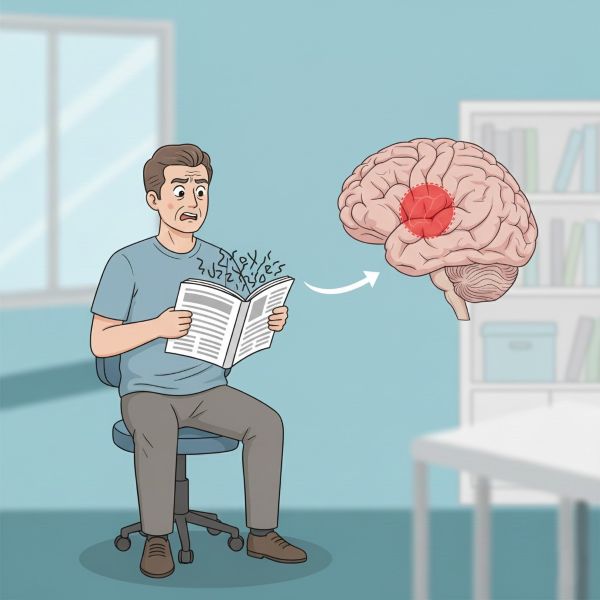Alexia
Definition and Overview
Alexia is an acquired disorder of reading due to brain injury. While the term dyslexia is often used for developmental reading difficulties, alexia specifically refers to the loss of a previously acquired reading ability. Alexias are broadly categorized into two groups: peripheral alexias, which are defects in perceiving the visual word form, and central alexias, which are breakdowns in deriving meaning from the written word.

Alexia is the acquired inability to read, often described as 'word blindness'. It results from damage to brain regions responsible for language and visual processing.
Peripheral Alexias (Visual Reading Disorders)
In these disorders, other language functions are often intact. The primary issue is with decoding the visual script.
- Alexia without Agraphia (Pure Alexia): This is the classic peripheral alexia. Patients lose the ability to read words but can still write normally—though they cannot read what they have just written. They adopt a laborious letter-by-letter reading strategy. This syndrome is caused by damage to the left occipito-temporal junction and is often associated with a right homonymous hemianopia and color anomia.
- Hemianopic Alexia: Reading difficulty arises when a right homonymous hemianopia affects central vision, making it hard to scan text to the right. This is often caused by a posterior cerebral artery infarction.
- Neglect Alexia: As part of a hemispatial neglect syndrome (usually from a right-sided lesion), patients may fail to read the beginning (left side) of words.
Central Alexias (Linguistic Reading Disorders)
These alexias are associated with broader language deficits (aphasia) and involve a breakdown in deriving meaning. Errors made in reading are known as paralexias.
- Alexia with Agraphia: The reading problem parallels the associated aphasia. For instance, in Broca's aphasia, reading is labored and agrammatic, while in Wernicke's aphasia, it is fluent but filled with errors. This is often part of the Gerstmann syndrome.
- Surface Dyslexia: Reading is done "by sound." Patients can read phonetically regular words and nonwords but struggle with exception words (e.g., "pint" is pronounced to rhyme with "mint"). This is seen with left temporal lobe pathology.
- Phonological Dyslexia: Reading is done "by sight." Patients can read familiar words but are unable to sound out and read unfamiliar or nonwords. This is associated with left temporo-parietal pathology.
- Deep Dyslexia: A severe form with an inability to read nonwords, accompanied by semantic errors (e.g., reading "sister" as "uncle"). This is seen with extensive left hemisphere damage.
References
Benson DF, Ardila A. Aphasia: a clinical perspective. New York: OUP, 1996: 180-211
Binder JR, Mohr JP. The topography of callosal reading pathways: a case control analysis. Brain 1992; 115: 1807-1826
Coslett HB. Acquired dyslexia. In: D’Esposito M (ed.). Neurological foundations of cognitive neuroscience. Cambridge: MIT Press, 2003: 109-127
Farah MJ. Visual agnosia: disorders of object recognition and what they tell us about normal vision. Cambridge: MIT Press, 1995
Leff A. Alexia. Advances in Clinical Neuroscience & Rehabilitation 2004; 4(3): 18,20,22
Cross References
Acalculia; Achromatopsia; Agnosia; Agraphia; Aphasia; Broca’s aphasia; Gerstmann syndrome; Hemianopia; Macula sparing, Macula splitting; Neglect; Prosopagnosia; Saccades; Simultanagnosia; Visual agnosia; Visual field defects; Wernicke’s aphasia

